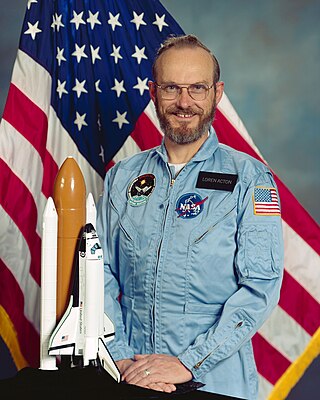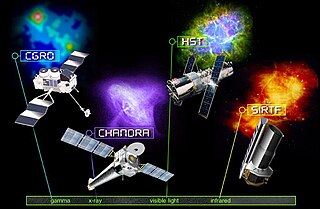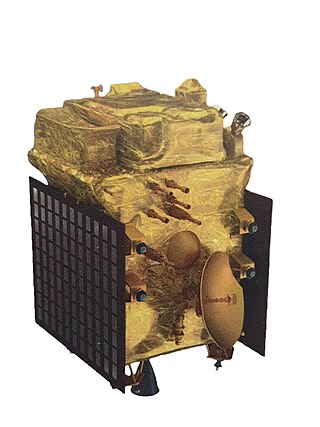
The Laboratory for Atmospheric and Space Physics (LASP) is a research organization at the University of Colorado Boulder. LASP is a research institute with over one hundred research scientists ranging in fields from solar influences, to Earth's and other planetary atmospherics processes, space weather, space plasma and dusty plasma physics. LASP has advanced technical capabilities specializing in designing, building, and operating spacecraft and spacecraft instruments.

Loren Wilber Acton is an American physicist who flew on Space Shuttle mission STS-51-F as a Payload Specialist for the Lockheed Palo Alto Research Laboratory. He is also the father of Cheryll Glotfelty, a leading ecocritic.

The Solar and Heliospheric Observatory (SOHO) is a European Space Agency (ESA) spacecraft built by a European industrial consortium led by Matra Marconi Space that was launched on a Lockheed Martin Atlas IIAS launch vehicle on 2 December 1995, to study the Sun. It has also discovered over 4,000 comets. It began normal operations in May 1996. It is a joint project between the European Space Agency (ESA) and NASA. SOHO was part of the International Solar Terrestrial Physics Program (ISTP). Originally planned as a two-year mission, SOHO continues to operate after over 25 years in space; the mission has been extended until the end of 2025, subject to review and confirmation by ESA's Science Programme Committee.

NASA's series of Great Observatories satellites are four large, powerful space-based astronomical telescopes launched between 1990 and 2003. They were built with different technology to examine specific wavelength/energy regions of the electromagnetic spectrum: gamma rays, X-rays, visible and ultraviolet light, and infrared light.

Transition Region and Coronal Explorer was a NASA heliophysics and solar observatory designed to investigate the connections between fine-scale magnetic fields and the associated plasma structures on the Sun by providing high resolution images and observation of the solar photosphere, the transition region, and the solar corona. A main focus of the TRACE instrument is the fine structure of coronal loops low in the solar atmosphere. TRACE is the third spacecraft in the Small Explorer program, launched on 2 April 1998, and obtained its last science image on 21 June 2010, at 23:56 UTC.

The Solar Orbiter (SO) is a Sun-observing probe developed by the European Space Agency (ESA) with a National Aeronautics and Space Administration (NASA) contribution. Solar Orbiter, designed to obtain detailed measurements of the inner heliosphere and the nascent solar wind, will also perform close observations of the polar regions of the Sun which is difficult to do from Earth. These observations are important in investigating how the Sun creates and controls its heliosphere.
Solar physics is the branch of astrophysics that specializes in the study of the Sun. It deals with detailed measurements that are possible only for our closest star. It intersects with many disciplines of pure physics, astrophysics, and computer science, including fluid dynamics, plasma physics including magnetohydrodynamics, seismology, particle physics, atomic physics, nuclear physics, stellar evolution, space physics, spectroscopy, radiative transfer, applied optics, signal processing, computer vision, computational physics, stellar physics and solar astronomy.

STEREO is a solar observation mission. Two nearly identical spacecraft were launched in 2006 into orbits around the Sun that cause them to respectively pull farther ahead of and fall gradually behind the Earth. This enabled stereoscopic imaging of the Sun and solar phenomena, such as coronal mass ejections.

The Solar Dynamics Observatory (SDO) is a NASA mission which has been observing the Sun since 2010. Launched on 11 February 2010, the observatory is part of the Living With a Star (LWS) program.
The UCL Mullard Space Science Laboratory (MSSL) is the United Kingdom's largest university space research group. MSSL is part of the Department of Space and Climate Physics at University College London (UCL), one of the first universities in the world to conduct space research. Since its establishment, MSSL has participated in 35 satellite missions, 10 of which are currently in operation, and in over 200 sounding rocket experiments.

Hinode, formerly Solar-B, is a Japan Aerospace Exploration Agency Solar mission with United States and United Kingdom collaboration. It is the follow-up to the Yohkoh (Solar-A) mission and it was launched on the final flight of the M-V rocket from Uchinoura Space Center, Japan on 22 September 2006 at 21:36 UTC. Initial orbit was perigee height 280 km, apogee height 686 km, inclination 98.3 degrees. Then the satellite maneuvered to the quasi-circular sun-synchronous orbit over the day/night terminator, which allows near-continuous observation of the Sun. On 28 October 2006, the probe's instruments captured their first images.

Aditya L1 is a planned coronagraphy spacecraft to study solar atmosphere, currently being designed and developed by the Indian Space Research Organisation (ISRO) and various other Indian research institutes. It will be inserted in a halo orbit around the L1 point between the Earth and the Sun where it will study the solar atmosphere, solar magnetic storms and its impact on environment around Earth.

An X-ray astronomy satellite studies X-ray emissions from celestial objects, as part of a branch of space science known as X-ray astronomy. Satellites are needed because X-radiation is absorbed by the Earth's atmosphere, so instruments to detect X-rays must be taken to high altitude by balloons, sounding rockets, and satellites.

Space research is scientific study carried out in outer space, and by studying outer space. From the use of space technology to the observable universe, space research is a wide research field. Earth science, materials science, biology, medicine, and physics all apply to the space research environment. The term includes scientific payloads at any altitude from deep space to low Earth orbit, extended to include sounding rocket research in the upper atmosphere, and high-altitude balloons.

Interface Region Imaging Spectrograph (IRIS), also called Explorer 94 and SMEX-12, is a NASA solar observation satellite. The mission was funded through the Small Explorer program to investigate the physical conditions of the solar limb, particularly the interface region made up of the chromosphere and transition region. The spacecraft consists of a satellite bus and spectrometer built by the Lockheed Martin Solar and Astrophysics Laboratory (LMSAL), and a telescope provided by the Smithsonian Astrophysical Observatory (SAO). IRIS is operated by LMSAL and NASA's Ames Research Center.


The Lynx X-ray Observatory (Lynx) is a NASA-funded Large Mission Concept Study commissioned as part of the National Academy of Sciences 2020 Astronomy and Astrophysics Decadal Survey. The concept study phase is complete as of August 2019, and the Lynx final report has been submitted to the Decadal Survey for prioritization. If launched, Lynx would be the most powerful X-ray astronomy observatory constructed to date, enabling order-of-magnitude advances in capability over the current Chandra X-ray Observatory and XMM-Newton space telescopes.

Imaging X-ray Polarimetry Explorer, commonly known as IXPE or SMEX-14, is a space observatory with three identical telescopes designed to measure the polarization of cosmic X-rays of black holes, neutron stars, and pulsars. The observatory, which was launched on 9 December 2021, is an international collaboration between NASA and the Italian Space Agency (ASI). It is part of NASA's Explorers program, which designs low-cost spacecraft to study heliophysics and astrophysics.
















